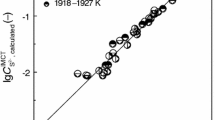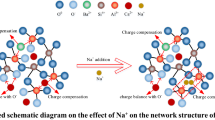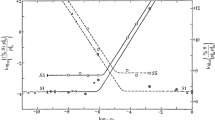Abstract
A sulfide capacity prediction model of CaO-SiO2-MgO-FeO-MnO-Al2O3 ladle furnace (LF) refining slags has been developed based on the ion and molecule coexistence theory (IMCT). The predicted sulfide capacity of the LF refining slags has better accuracy than the measured sulfide capacity of the slags at the middle and final stages during the LF refining process. Increasing slag binary basicity, optical basicity, and the Mannesmann index can lead to an increase of the predicted sulfide capacity for the LF refining slags as well as to an increase of the sulfur distribution ratio between the slags and molten steel at the middle and final stages during the LF refining process. The calculated equilibrium mole numbers, mass action concentrations of structural units or ion couples, rather than mass percentages of components, are recommended to represent the slag composition for correlating with the sulfide capacity of the slags. The developed sulfide capacity IMCT model can calculate not only the total sulfide capacity of the slags but also the respective sulfide capacity of free CaO, MgO, FeO, and MnO in the slags. The comprehensive contribution of the combined ion couples (Ca2+ + O2−) and (Mn2+ + O2−) on the desulfurization reactions accounts for 96.23 pct; meanwhile, the average contribution of the ion couple (Fe2+ + O2−) and (Mg2+ + O2−) only has a negligible contribution as 3.13 pct and 0.25 pct during the LF refining process, respectively. The oxygen activity of bulk molten steel in LF is controlled by the [Al]–[O] equilibrium, and the oxygen activity of molten steel at the slag–metal interface is controlled by the (FeO)–[O] equilibrium. The ratio of the oxygen activity of molten steel at the slag–metal interface to the oxygen activity of bulk molten steel will decrease from 37 to 5 at the initial stage, and further decrease from 28 to 4 at the middle stage, but will maintain at a reliable constant as 5 to 14 at the final stage during the LF refining process. The proposed high-oxygen potential layer of molten steel beneath the slag–metal interface can be quantitatively verified.



















Similar content being viewed by others
Abbreviations
- a i :
-
activity of component i in molten steel or slags (−)
- a O,interface :
-
oxygen activity of molten steel at slag–metal interface (−)
- a O,(FeO)–[O] :
-
calculated oxygen activity of molten steel at slag–metal interface based on (FeO)–[O] equilibrium (−)
- a O,sensor :
-
measured oxygen activity in molten steel by oxygen sensor (−)
- B :
-
slag binary basicity, i.e., ratio of (pct CaO) to (pct SiO2) (−)
- \( C_{{{\text{S}}^{2 - } }} \) :
-
sulfide capacity of slags (−)
- \( C_{{{\text{S}}^{2 - } , {\text{calculated}}}}^{\text{IMCT}} \) :
-
calculated total sulfide capacity of slags by the IMCT model (−)
- \( C_{{{\text{S}}^{ 2- } , {\text{ calcualted}}}}^{i} \) :
-
calculated total sulfide capacity of slags by model i (−)
- \( C_{{{\text{S}}^{2 - } ,i}} \) :
-
respective sulfide capacity of free component i or ion couple i in slags (−)
- \( C_{{{\text{S}}^{2 - } , { i, \text{calculated}}}}^{\text{IMCT}} \) :
-
calculated respective sulfide capacity of free component i or ion couple i in slags by IMCT model (−)
- \( C_{{{\text{S}}^{2 - } , { i, \text{measured}}}} \) :
-
calculated respective sulfide capacity of free component i or ion couple i in slags from measured data (−)
- \( C_{{{\text{S}}^{2 - } ,{\text{ index}}}} \) :
-
sulfide capacity index of slags (−)
- \( C^i_{{{\text{S}}^{2 - } ,{\text{ index, calculated}}}} \) :
-
calculated sulfide capacity index of slags by model i (−)
- \( C_{{{\text{S}}^{2 - } , {\text{ index, measured}}}}^{{ ( {\text{FeO)}} - [{\text{O}}]}} \) :
-
measured sulfide capacity index of slags from measured sulfur distribution ratio L S,measured of the slags equilibrated with molten steel (−)
- \( C_{{{\text{S}}^{2 - } , {\text{ measured}}}}^{{ ( {\text{FeO)}} - [{\text{O}}]}} \) :
-
measured sulfide capacity of slags based on (FeO)–[O] equilibrium (−)
- \( e_{i}^{j} \) :
-
activity interaction coefficient of component j on component i in molten steel based on the mass percentage as concentration unit and 1 mass percent (1 pct) as a standard state (−)
- f i :
-
activity coefficient of component i in molten steel (−)
- \( \Updelta_{\text{r}}G_{{{\text{m}}, \, i}}^{\Uptheta } \) :
-
standard molar Gibbs free energy change of forming component i or structural unit i in slags (J/mol)
- \( \Updelta_{\text{r}} G_{{{\text{m}},{\text{ S}}_{2} ,{\text{ gas - metal}}}}^{\Uptheta } \) :
-
standard molar Gibbs free energy change of desulfurization reaction from metal for forming gaseous sulfur S2 based on gas–metal equilibrium (J/mol)
- \( K_{i}^{\Uptheta } \) :
-
equilibrium constant of chemical reaction for forming component i or structural unit i (−)
- \( K_{{{\text{S}}^{2 - } ,{\text{ slag - gas}}}}^{\Uptheta } \) :
-
chemical reaction equilibrium constant of absorbing sulfur reaction from gas for forming sulfide in slags based on slag–gas equilibrium (−)
- \( K_{{{\text{S}}^{2 - } ,{\text{ slag - metal}}}}^{\Uptheta } \) :
-
chemical reaction equilibrium constant of desulfurization reaction from metal for forming sulfide in slags by ion exchange reaction between slag and metal (−)
- L S :
-
sulfur distribution ratio between slags and molten steel (–)
- \( L_{{{\text{S}},{\text{ calculated}}}}^{\text{IMCT}} \) :
-
calculated total sulfur distribution ratio between slags and molten steel by the IMCT model (−)
- L S,i :
-
calculated respective sulfur distribution ratio of free component i or ion couple i in slags (−)
- L S,measured :
-
measured total sulfur distribution ratio between slags and molten steel (−)
- MI :
-
Mannesmann index defined as \( {{MI}} \equiv B/\left( {{\text{pct Al}}_{2} {\text{O}}_{3} } \right) = \left( {\text{pct CaO}} \right)/\left( {\left( {{\text{pct SiO}}_{2} } \right)\left( {{\text{pct Al}}_{2} {\text{O}}_{3} } \right)} \right) \) (−)
- M i :
-
molecular weight of element i or component i (g/mol)
- n i :
-
equilibrium mole number of structural unit i or ion couple i in 100-g slags based on the IMCT (mol)
- \( \sum {n_{i}^{0} } \) :
-
total mole number of all components in a 100-g slags before reaction equilibrium (mol)
- ∑n i :
-
total equilibrium mole number of all structural units in 100-g slags based on the IMCT (mol)
- N i :
-
mass action concentrations of structural unit i or ion couple i in slags based on the IMCT (−)
- p i :
-
partial pressure of component i in gas (Pa)
- \( P^{\Uptheta } \) :
-
standard pressure of gas at sea level and 273 K (0 °C) as 101,325 Pa (Pa)
- R :
-
gas constant (8.314 J/(mol K))
- T :
-
absolute temperature (K)
- X i :
-
mole fraction of component i in slags (−)
- (pct i):
-
mass percentage of component i in slags (−)
- [pct i]:
-
mass percentage of component i in molten steel (−)
- Λ:
-
optical basicity of slags (–)
- \( \xi_{\text{interaction}}^{i - j} \) :
-
interaction coefficient of component i to j in slags defined in the KTH model (–)
References
C.J.B. Fincham and F.D. Richardson: Proc. R. Soc. Lond. A, 1954, vol. 223A, pp. 40–62.
F.D. Richardson and C.J.B. Fincham: J. Iron Steel Inst., 1954, vol. 178, no. 9, pp. 4–15.
X.M. Yang, T.Z. Liu, Z.C. Guo, X.P. Yu, and D.G. Wang: J. Iron Steel Res., 1995, vol. 7, no. 6, pp. 1–8.
X.M. Yang, Z.C. Guo, D.G. Wang, and Y.S. Xie: Iron Steel, 1996, vol. 31 (suppl.), pp. 25–31.
C.B. Shi, X.M. Yang, J.S. Jiao, C. Li, and H.J. Guo: ISIJ Int., 2010, vol. 50, no. 10, pp. 1362–72.
M.A.T. Andersson, P.G. Jönsson, and M.M. Nzotta: ISIJ Int., 1999, vol. 39, no. 11, pp. 1140–49.
M. Andersson: Ph.D. Dissertation, KTH, Stockholm, Sweden, 2000.
D.J. Sosinsky and I.D. Sommerville: Metall. Trans. B, 1986, vol. 17B, pp. 331–37.
R.W. Young, J.A Duffy, G.J. Hassall, and Z. Xu: Ironmaking Steelmaking, 1992, vol. 19, no. 3, pp. 201–19.
A. Shankar, M. Gornerup, A.K. Lahiri, and S. Seetharaman: Metall. Mater. Trans. B, 2006, vol. 37B, pp. 941–47.
Y. Taniguchi, N. Sano, and S. Seetharaman: ISIJ Int., 2009, vol. 49, no. 2, pp. 156–63.
R.G. Reddy and M. Blander: Metall. Trans. B, 1987, vol. 18B, pp. 591–96.
D. Sichen, R. Nilsson, and S. Seetharaman: Steel Res., 1995, vol. 66, no. 11, pp. 458–62.
M.M. Nzotta, D. Sichen, and S. Seetharaman: ISIJ Int., 1998, vol. 38, no. 11, pp. 1170–79.
M.M. Nzotta, D. Sichen, and S. Seetharaman: ISIJ Int., 1999, vol. 39, no. 7, pp. 657–63.
M.M. Nzotta, D. Sichen, and S. Seetharaman: Metall. Mater. Trans. B, 1999, vol. 30B, pp. 909–20.
A. Shankar: Ironmaking Steelmaking, 2006, vol. 33, no. 5, pp. 413–18.
M.A.T. Andersson, P.G. Jönsson, and M. Hallberg: Ironmaking Steelmaking, 2000, vol. 27, no. 4, pp. 286–92.
M. Hino, S. Kitagawa, and S. Ban-Ya: ISIJ Int., 1993, vol. 33, no. 1, pp. 36–42.
R. Nilsson, S. Seetharaman, and K.T. Jacob: ISIJ Int., 1994, vol. 34, no. 11, pp. 876–82.
S. Ban-Ya, M. Hobo, T. Kaji, T. Itoh, and M. Hino: ISIJ Int., 2004, vol. 44, no. 11, pp. 1810–16.
X.M. Yang, J.S. Jiao, R.C. Ding, C.B. Shi, and H.J. Guo: ISIJ Int., 2009, vol. 49, no. 12, pp. 1828–37.
X.M. Yang, C.B. Shi, M. Zhang, G.M. Chai, and F. Wang: Metall. Mater. Trans. B, 2011, vol. 42B, pp. 1150–80.
J. Zhang: Acta Metall Sin., 2001, vol. 14, no. 3, pp. 177–90.
J. Zhang: J. Univ. Sci. Technol. Beijing, 2002, vol. 9, no. 2, pp. 90–98.
J. Zhang: Rare Metals, 2004, vol. 23, no. 3, pp. 209–13.
J. Zhang: Computational Thermodynamics of Metallurgical Melts and Solutions, Metallurgical Industry Press, Beijing, China, 2007.
X.M. Yang, C.B. Shi, M. Zhang, and D.M. Li: The Chinese J. Process Eng., 2011, vol. 11, no. 1, pp. 86–91.
R. Tsujino, J. Nakashima, M. Hirai, and Y. Yamada: ISIJ Int., 1989, vol. 29, no. 1, pp. 92–95.
M. Ohya: Ferrous Metallurgy and Thermodynamics, Nikkan Kogyo Shimbun-sha, Tokyo, Japan, 1971.
J. Yang, M. Kuwabara, K. Okumura, and M. Sano: ISIJ Int., 2005, vol. 45, no. 12, pp. 1795–1803.
J. Lee and K. Morita: ISIJ Int., 2004, vol. 44, no. 2, pp. 235–42.
E.T. Turkdogan: ISIJ Int., 2000, vol. 40, no. 10, pp. 964–70.
T.R. Galiullin, Y.N. Nosov, A.A. Mikhalev, Y.V. Shkola, and A.V. Makhan’kov: Steel in Translation, 2007, vol. 37, no. 10, pp. 863–66.
T. Tsao and H.G. Katayama: ISIJ Int., 1986, vol. 26, no. 8, pp. 717–23.
The Recommended Values for the Equilibrium of Steelmaking Reactions, The Japan Society for the Promotion of Science, ed. Nikan Kogyo Shinbunsha, Tokyo, 1968.
G.K. Sigworth and J.F. Elliott: Met. Sci., 1974, vol. 8, no. 9, pp. 298–310.
J.F. Elliott, M. Gleiser, and V. Ramakrisha: Thermochemistry for Steelmaking, vol. II, Addison-Wesley Publishing Co., London, UK, 1963, pp. 620–21.
H. Ohta and H. Suito: Metall. Mater. Trans. B, 1995, vol. 26B, pp. 295–303.
J. Tanabe, I. Seki, and K. Nagata: ISIJ Int., 2006, vol. 46, no. 2, pp. 169–73.
Acknowledgments
This work was supported by a grant of No. 51174186 from the National Natural Science Foundation of China. The helpful assistants from the Shougang Qian’an Iron and Steel Company Limited for carrying out the industrial experiments are sincerely appreciated.
Author information
Authors and Affiliations
Corresponding author
Additional information
Manuscript submitted March 12, 2011.
Rights and permissions
About this article
Cite this article
Yang, XM., Zhang, M., Shi, CB. et al. A Sulfide Capacity Prediction Model of CaO-SiO2-MgO-FeO-MnO-Al2O3 Slags during the LF Refining Process Based on the Ion and Molecule Coexistence Theory. Metall Mater Trans B 43, 241–266 (2012). https://doi.org/10.1007/s11663-011-9612-4
Published:
Issue Date:
DOI: https://doi.org/10.1007/s11663-011-9612-4




